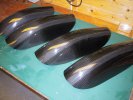|












| |
Canopy of carbon and epoxy.

There may be several reasons for wanting to exchange the
original translucent canopy with one made of carbon-fiber. My own reasons
are the following :
-
Weight reduction, a typical translucent canopy is 30-40g
heavier than one made from carbon-fiber. In addition the cockpit interior is
not visible saving weight of pilot etc. and the cockpit floor can be removed
to save another 30-40g.
-
More room inside fuselage. Some models with one-piece
wings have limited space between wing and cockpit floor. To make more
room for fuel-tank in CG-area the cockpit floor can be removed.
With a translucent canopy this will not be pretty, with one of carbon-fiber
it's OK.
-
Looks. Some find a shiny carbon-fiber surface more beautiful
than a translucent plastic canopy. Some models comes with a totally
clear canopy, in air this is invisible making it look like a part of the
plane is missing.
First of all, I use the inside of the original translucent
canopy as a mould. The carbon-cloth that I use is of weight 200g/m2.
=== DONE ===
|